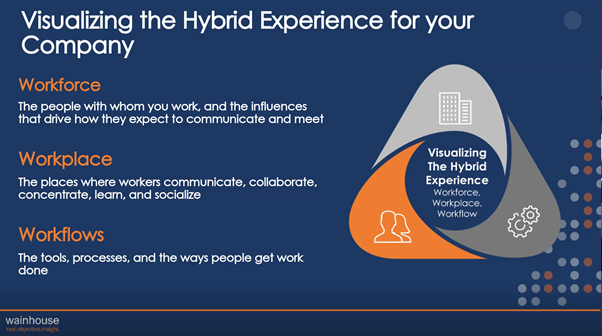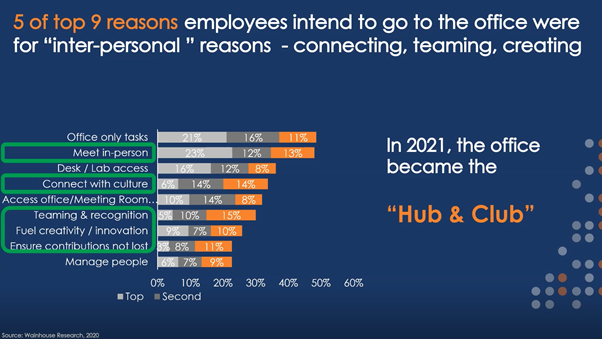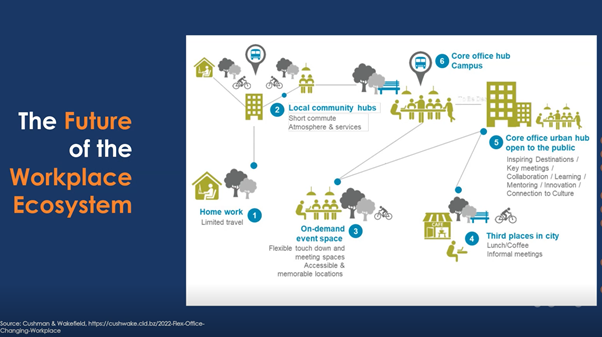The world of ‘work’ has changed significantly in the last decade. Since video conferencing was first introduced, the term ‘hybrid working’ has etched its way into the vernacular of almost every organization in the world.
In a recent webinar I hosted with John Ruthven, CEO at IR and Craig Durr, Senior Analyst at Wainhouse Research, we discussed the rapid evolution of the workplace, what hybrid work looks like today, and tips on how organizations should approach the hybrid workplace to make it seamless for everyone.
Download Your Ultimate Guide to Future-Proofing the Hybrid Workplace
The hybrid workplace framework
Wainhouse Research developed ‘The three Ws’ framework to create a simple perspective. It perfectly encapsulates what the hybrid workplace represents and how to frame it in the context of your environment.
Workplace
There is no longer a single defined physical place in which to work. Today, the workplace is an umbrella term for the many places where workers communicate, collaborate, concentrate, learn and socialize.
Workforce
The most important consideration is the people you work with. It’s hard to imagine a successful business without people collaborating. This part of the framework defines the influences that drive how they expect to communicate and meet.
Workflows
The way people achieve their work objectives is different. Technological innovation and ongoing development have allowed more tools and processes to influence how we get things done.

Earning the commute
The pandemic undoubtedly altered the way we work forever, proving that people can be just as efficient, productive, and happier without having to commute for hours every week to get to a workplace.
In 2021, the office became a place to go for ‘inter-personal’ reasons, rather than to punch a timeclock. The onus was on employers to incentivize their workers to commit to the commute. They discovered the top five reasons motivating employees to go to the office were based on connectivity and team or personal collaboration with peers.

The workplace: From static to dynamic, flexible, and agile
The future workplace ecosystem will look something like the illustration below, with a far more open, flexible, and agile structure. Organizations are giving up static office real estate located in the centre of large metropolitan areas.
Instead, hybrid working has made way for more activity-based environments. This includes centrally located community hubs, informal meeting places, on-demand event spaces and more open urban campuses for crucial meetings and collaboration.

Employee expectations
There is no doubt Millennials and Gen Z are the future of the digital workplace. With more and more baby boomers leaving the workforce, and the advent of a dispersed workplace, they are the foundation of the digital generation.
They were born and raised with technology, and they know how to utilize and interact with it to the greatest advantage. For the first time in history, employees have more leverage over how they work, meaning there are new expectations to be met by employers.
Meetings are the new battleground for inclusivity
For many organizations experiencing a partial return to the office, collaborative tools need to provide inclusivity for all meeting participants. In the past, meetings took place in a room with several participants who were all on equal footing and physically present. Anyone joining the meeting remotely felt like an outsider.
Today, the whole dynamic of meetings and conferences has changed dramatically, thanks to the constantly developing sophistication of communication platforms like Zoom, Microsoft Teams and Webex. Technology tools allow every meeting participant, whether remote or in-person, to experience the same level of inclusivity and participation.
The challenges of bring-your-own-devices (BYODs)
One of the critical causes of friction and complexity for IT administration is the use of uncertified, non-enterprise grade devices like cameras, headsets, and microphones.
Working remotely means that in a distributed network, employees communicate and collaborate using domestic devices intended for use in personal communication. This can cause poor audio and video experiences and even derail important meetings and conferences.
Organizations will need to address this by ensuring all employees use enterprise-grade, fully optimized and certified communication devices.
Observability: Measuring success in the hybrid workplace
The nature of a hybrid working environment means that enterprises may have people working from outside locations on one day, one hundred employees in the office on another day, and possibly 500 in the office the next.
The bottom line is that devices, platforms, and space availability need to work no matter how many people turn up or what spaces they inhabit.
Managing this changing workflow means understanding what’s taking place in the workspaces. Not only in terms of workspace capacity planning but knowing what devices are available, and being utilized, what spaces are being used, and how.
Data, insights, and visibility
In today’s hybrid working environment, performance and availability issues impede success. Observability solutions need to consume, process and analyze metrics, logs and traces to provide a complete understanding of every aspect of an organization’s processes.
Data and analytics are crucial to understanding end-user performance and which user-communities are impacted. Being able to see every level of your hybrid working ecosystem provides layers of intelligence and insights that create team cohesion, cost management, innovation, and growth.
There is no single roadmap for hybrid working success because it’s an ongoing evolution, and every organization is different. But by keeping these themes top of mind, you can develop key strategies to optimize your hybrid workplace and overcome IT challenges to ensure success now and well into the future.
Want to know more? Watch the full webinar.





